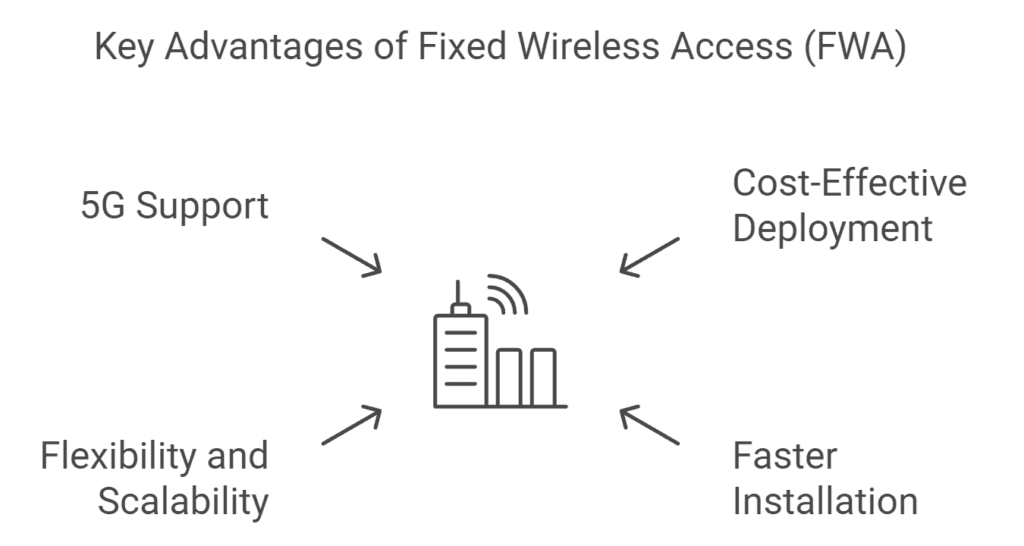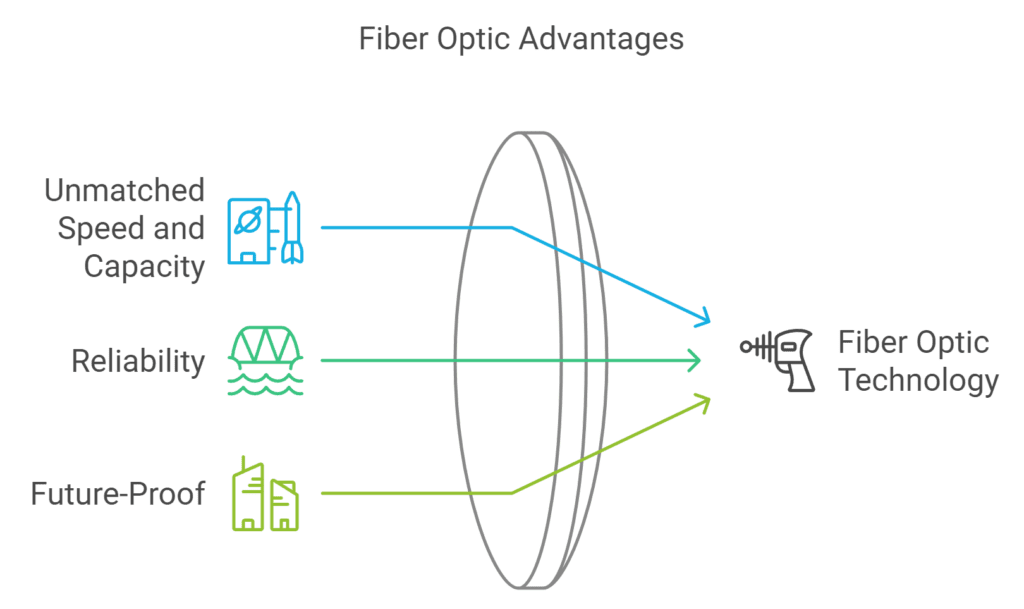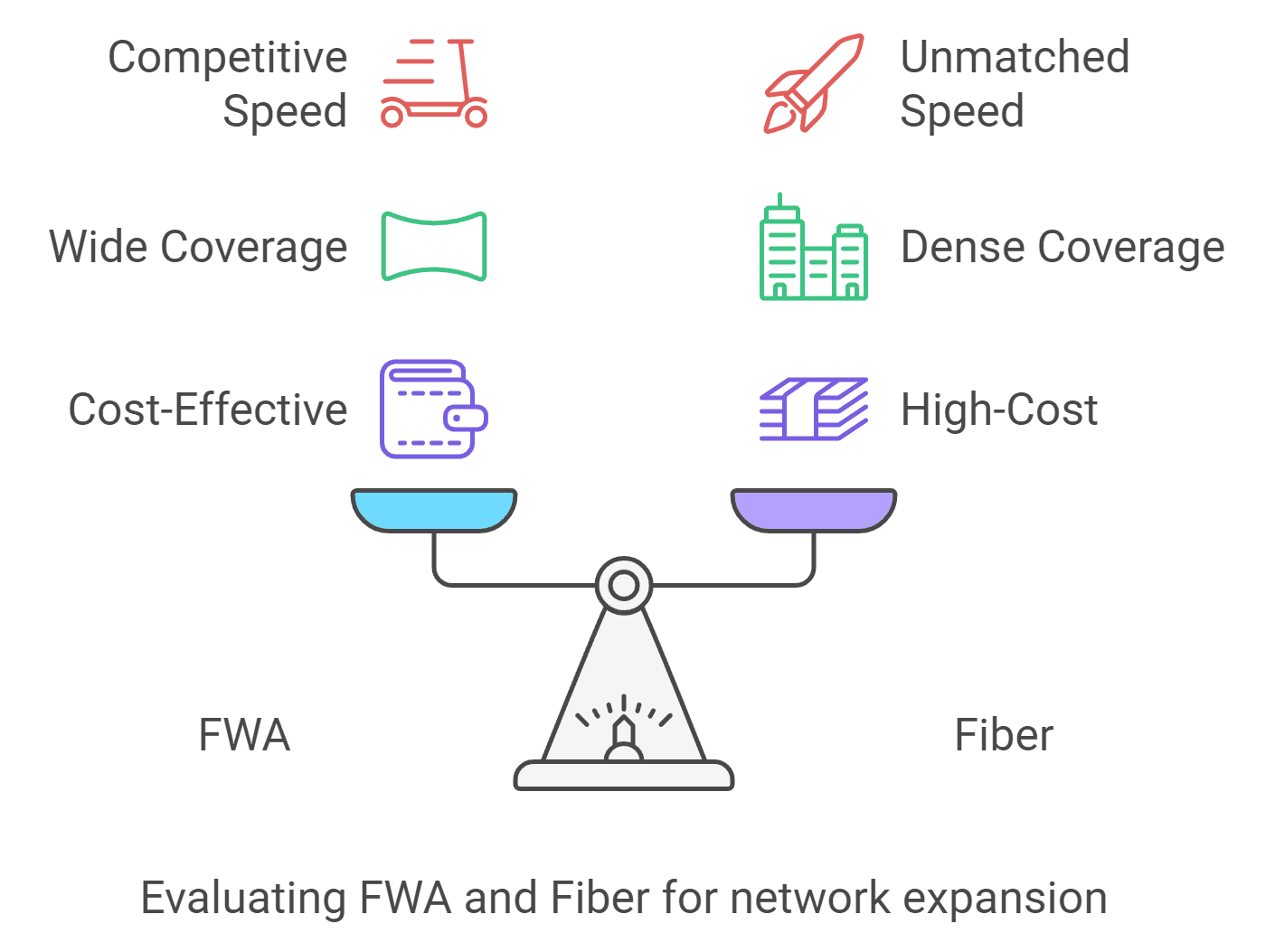Fixed Wireless Access vs Fiber: Which is Better for Network Expansion

In the telecom world, network expansion is critical for operators aiming to deliver fast, reliable internet in both urban and rural areas. Two prominent technologies in this space are Fixed Wireless Access (FWA) and fiber optic networks (Fiber). Choosing between them depends on various factors, including cost, coverage, speed, and ease of deployment.
This article explores the advantages and challenges of Fixed Wireless Access vs Fiber while examining how Aircom’s advanced Radio Planning Tool ASSET optimizes FWA deployments for better performance and cost-efficiency.
Fixed Wireless Access (FWA): Bridging the Digital Divide
Fixed Wireless Access (FWA) delivers broadband using wireless signals between base stations and customer premises equipment. It’s ideal for areas where laying fiber is expensive or time-consuming.

Key Advantages of FWA
- Cost-Effective Deployment: FWA uses existing wireless infrastructure, making it more affordable than fiber, especially in rural areas.
- Faster Installation: FWA can be deployed quickly compared to fiber, which requires months of planning, trenching, and approvals.
- Flexibility and Scalability: FWA allows operators to easily add capacity by upgrading equipment or deploying new base stations.
- 5G Support: FWA, particularly with 5G, can offer speeds comparable to fiber, especially in urban areas.
Fiber: The Gold Standard for Speed and Reliability
Fiber optic networks use light to transmit data, providing unparalleled speed and reliability, making it the backbone of many telecommunications infrastructures.
Key Advantages of Fiber

- Unmatched Speed and Capacity: Fiber offers almost limitless bandwidth, ideal for high-demand users and data centers.
- Reliability: Fiber is less susceptible to interference, delivering consistent and reliable performance.
- Future-Proof: Fiber can handle future technologies and higher data demands with minimal upgrades, making it a long-term investment.
Challenges of Fiber Deployment
Fiber installation requires significant investment in physical infrastructure, regulatory approvals, and long deployment timelines, especially in rural or difficult-to-reach areas.
FWA vs Fiber: Which is Better for Network Expansion?

- Cost-Effectiveness: FWA is more cost-effective for rural and suburban network expansion since it uses wireless towers rather than expensive cabling. Fiber, while more expensive, is often prioritized in high-demand urban areas.
- Coverage: FWA is better suited for large rural areas or places where physical deployment of fiber is impractical. Fiber offers better reliability and coverage in high-density areas.
- Speed and Reliability: Fiber offers unmatched speeds and reliability, but FWA, especially with 5G, is closing the gap and providing competitive speeds in both rural and urban settings.
- Scalability: FWA is more flexible and scalable, making it easier for operators to add capacity as demand grows. Fiber, while future-proof, is less adaptable and more costly to scale.
The Role of Aircom’s Radio Planning Tool ASSET in Fixed Wireless Access
Aircom’s Radio Planning Tool ASSET helps operators optimize FWA deployments by accurately modeling coverage, managing spectrum, and optimizing costs.
Key Features of ASSET for Fixed Wireless Access
- Advanced propagation models: ASSET uses advanced propagation models that accurately simulate how wireless signals will behave in different environments. This allows RF engineers to predict coverage, capacity, and performance before deploying the network, ensuring optimal site placement and network design.
- Spectrum Management: Spectrum is a critical resource for FWA. ASSET provides tools to manage spectrum efficiently, minimizing interference and ensuring that operators can maximize the use of available frequencies.
- Cost Optimization: By simulating network performance in different configurations, ASSET helps operators optimize their network design to deliver maximum performance at the lowest cost. This is especially valuable for FWA, where cost-efficiency is key to expanding coverage in rural or underserved areas.
- Scalability: ASSET allows operators to model network growth scenarios, helping them plan for future expansion and upgrades. This is particularly useful for Fixed Wireless Access deployments, which often need to scale quickly in response to growing demand.
- Integration with 5G: ASSET is designed to support 5G network planning, enabling operators to design 5G Fixed Wireless Access networks that leverage the latest technologies like massive MIMO and beamforming for superior performance.
Conclusion: Which is Better?
Both Fixed Wireless Access and fiber have their merits. Fiber excels in high-demand urban areas, while FWA offers a cost-effective, scalable solution for rural or hard-to-reach regions. With tools like Aircom’s ASSET, operators can maximize the benefits of Fixed Wireless Access, delivering reliable high-speed internet where it’s most needed.
How can we help?
For over 30 years, Aircom has helped network operators run state-of-the-art mobile networks and profitable businesses. Learn how we can help you in the areas critical to the success of modern CSPs.






